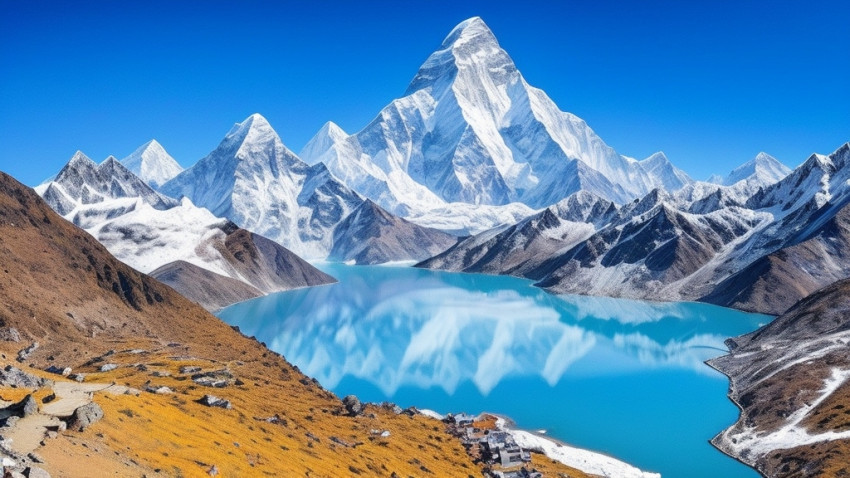
Introduction
Embarking on the Everest Base Camp Trek via Gokyo Lake is a journey into the heart of the Himalayas, offering an unparalleled adventure for trekking enthusiasts. This iconic trek combines the awe-inspiring landscapes of Gokyo Lake with the challenge of reaching the base camp of the world's highest peak, Mount Everest.
Gokyo Lake - A Jewel in the Himalayas
Gokyo Lake, nestled in the Gokyo Valley, is a pristine gem surrounded by towering peaks. Its turquoise waters reflect the majesty of Cho Oyu, the world's sixth-highest mountain. The lake serves as a breathtaking backdrop for trekkers on the route to Everest Base Camp.
Route Details
The trek unfolds through a carefully planned itinerary, guiding trekkers through picturesque villages, suspension bridges, and high-altitude terrain. Key stops include Namche Bazaar, Gokyo Ri, and, of course, Everest Base Camp itself. Each stage of the journey provides unique vistas and challenges, making it a truly unforgettable experience.
Preparing for the Journey
Before embarking on this epic adventure, trekkers must obtain necessary permits and documentation. Physical fitness and training are crucial, ensuring participants are well-prepared for the demanding trekking conditions and high altitudes.
Accommodations on the Trek
Teahouses and lodges along the trail offer cozy resting spots for trekkers. Booking in advance is recommended, and the experience of staying in these accommodations provides insight into local hospitality.
Weather Challenges
The trek's timing is vital, considering the diverse weather conditions in the Himalayas. Trekkers should plan their journey during the optimal season to enjoy clear skies and avoid harsh weather challenges.
Unique Flora and Fauna
The trek exposes trekkers to a rich Himalayan ecosystem, showcasing unique flora and fauna. Rare species like the elusive snow leopard or the Himalayan tahr may make an appearance, adding an extra layer of excitement to the journey.
Cultural Encounters
Interacting with local Sherpa communities offers trekkers a glimpse into their rich cultural heritage. Witnessing traditional practices and rituals enhances the overall trekking experience.
Altitude Sickness Awareness
Awareness of altitude sickness symptoms and prevention methods is crucial for trekkers. Proper acclimatization, hydration, and recognizing early signs of sickness are essential components of a safe trek.
Equipment and Gear
Packing the right gear is paramount for a successful trek. From sturdy trekking boots to insulated clothing, trekkers must be equipped to handle the varying conditions along the trail.
Challenges and Rewards
The Everest Base Camp Trek via Gokyo Lake is not without its challenges. Trekkers face difficult terrain and changing weather, but the sense of accomplishment upon reaching their destination makes every hardship worthwhile.
Capturing Memories
Photography becomes a cherished part of the journey, with opportunities to capture the grandeur of the Himalayas. Trekkers are encouraged to document their adventure, creating lasting memories of this once-in-a-lifetime experience.
Responsible Trekking
Respecting the environment is paramount. Adhering to Leave No Trace principles ensures that the beauty of the Himalayas is preserved for future generations. Trekkers are encouraged to actively contribute to local conservation efforts.
Testimonials and Experiences
Real-life stories from fellow trekkers add a personal touch to the article. Shared experiences, insightful anecdotes, and lessons learned contribute to the collective knowledge of those considering the Everest Base Camp Trek via Gokyo Lake.
Conclusion
In conclusion, the Everest Base Camp Trek via Gokyo Lake offers a unique blend of natural beauty, cultural immersion, and personal challenge. It's not just a trek; it's a transformative journey that leaves an indelible mark on every participant.
FAQs
Is the Everest Base Camp Trek via Gokyo Lake suitable for beginners?
- While the trek is challenging, with proper preparation and fitness, beginners can successfully complete it.
What permits are required for the trek?
- Trekkers need permits such as the Sagarmatha National Park Permit and the TIMS card.
How can trekkers contribute to local conservation efforts?
- Participating in organized clean-up initiatives and supporting local sustainable practices are effective ways to contribute.
Are there medical facilities along the trekking route?
- Basic medical facilities are available, but it's advisable to carry a basic first aid kit.
Can the trek be done independently, or is a guide recommended?
- While some trekkers choose to go independently, hiring a guide enhances safety and provides valuable insights into the local culture.





